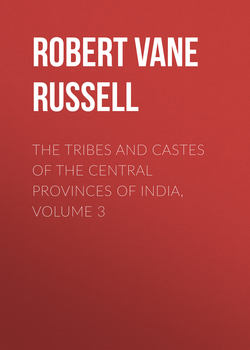Читать книгу The Tribes and Castes of the Central Provinces of India, Volume 3 - Robert Vane Russell - Страница 51
Gond
(e) Funeral Rites
33. Funeral ceremony
ОглавлениеAmong the Māria Gonds a drum is beaten to announce a death, and the news is sent to relatives and friends in other villages. The funeral takes place on the second or third day, when these have assembled. They bring some pieces of cloth, and these, together with the deceased’s own clothes and some money, are buried with him, so that they may accompany his spirit to the other world. Sometimes the women will put a ring of iron on the body. The body is borne on a hurdle to the burial- or burning-ground, which is invariably to the east of the village, followed by all the men and women of the place. Arrived there, the bearers with the body on their shoulders face round to the west, and about ten yards in front of them are placed three sāj leaves in a line with a space of a yard between each, the first representing the supreme being, the second disembodied spirits, and the third witchcraft. Sometimes a little rice is put on the leaves. An axe is struck three times on the ground, and a villager now cries to the corpse to disclose the cause of his death, and immediately the bearers, impelled, as they believe, by the dead man, carry the body to one of the leaves. If they halt before the first, then the death was in the course of nature; if before the second, it arose from the anger of offended spirits; if before the third, witchcraft was the cause. The ordeal may be thrice repeated, the arrangement of the leaves being changed each time. If witchcraft is indicated as the cause of death, and confirmed by the repeated tests, the corpse is asked to point out the sorcerer or witch, and the body is carried along until it halts before some one in the crowd, who is at once seized and disposed of as a witch. Sometimes the corpse may be carried to the house of a witch in another village to a distance of eight or ten miles. In Mandla in such cases a Gunia or exorciser formerly called on the corpse to go forward and point out the witch. The bearers then, impelled by the corpse, made one step forward and stopped. The exorciser then again adjured the corpse, and they made a step, and this was repeated again and again until they halted in front of the supposed witch. All the beholders and the bearers themselves thus thought that they were impelled by the corpse, and the episode is a good illustration of the power of suggestion. Frequently the detected witch was one of the deceased’s wives. In Mandla the cause of the man’s death was determined in the digging of his grave. When piling in the earth removed for the grave after burial, if it reached exactly to the surface of the ground, they thought that the dead man had died after living the proper span of his life. If the earth made a mound over the hole, they thought he had lived beyond his allotted time and called him Sīgpur, that is a term for a measure of grain heaped as high as it will stand above the brim. But if the earth was insufficient and did not reach to the level of the ground, they held that he had been prematurely cut off, and had been killed by an enemy or by a witch through magic.
Children at breast are buried at the roots of a mahua tree, as it is thought that they will suck liquor from them and be nourished as if by their mother’s milk. The mahua is the tree from whose flowers spirits are distilled. The body of an adult may also be burnt under a mahua tree so that the tree may give him a supply of liquor in the next world. Sometimes the corpse is bathed in water, sprinkled over with milk and then anointed with a mixture of mahua oil, turmeric and charcoal, which will prevent it from being reincarnated in a human body. In the case of a man killed by a tiger the body is burned, and a bamboo image of a tiger is made and thrown outside the village. None but the nearest relatives will touch the body of a man killed by a tiger, and they only because they are obliged to do so. None of the ornaments are removed from the corpse, and sometimes any other ornaments possessed by the deceased are added to them, as it is thought that otherwise the tiger into which his spirit passes will come back to look for them and kill some other person in the house. In some localities any one who touches the body of a man killed or even wounded by a tiger or panther is put temporarily out of caste. Yet the Gonds will eat the flesh of tigers and panthers, and also of animals killed and partly devoured by them. When a man has been killed by a tiger, or when he has died of disease and before death vermin have appeared in a wound, the whole family are temporarily out of caste and have to be purified by an elaborate ceremony in which the Bhumka or village priest officiates. The method of laying the spirit of a man killed by a tiger resembles that described in the article on Baiga.
